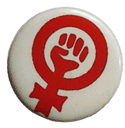This semester, my Pitzer College students are occupying what Stephanie Saxton calls “in-between spaces”: the kind of website that sits on the line between a feminist orientation and a friendly relation to mainstream culture “placing itself between lady-mag corporate culture and radical feminism—presumably for comfort reasons, so as not to alienate users from either side of the spectrum.” Working primarily in such in-between spaces, their work begs important questions, and suggests keen insights as well:
- can you have a radical feminist practice online based in an essentialist understanding of the body?
- can you have a radical online feminist practice that is not based on the body?
- can you have a radical online feminist practice that is based in fantasies of oppression?
- can you progressively link the fantasy (and possibility) of the online with the lived oppression of real bodies?
- can you have a radical feminist practice if you close access to insure safety and community, creating separate spheres (for example sites that are for lesbians or bi-women but are not open to queers or women of color)?
- while equality at the level of access and freedom of expression are a baseline for feminist interaction, are they enough?
- while self-determination over sexuality and voice are a baseline for feminist interaction online, are they enough?
- while being sex-positive and queer-friendly are a baseline for feminist interaction online, without an associated commitment to a political project, they are not enough.
- if you are sex-positive, you need to also destabilize gender and sexuality norms to be feminist.
- feminist sites that do not overtly account for race and complex gender and sexuality are not enough.
- feminist sites that limit the agency, authority, activity, and authoring of their users are not enough.
- mean humor, and aggressive commenting culture need rules of engagement.
- intimacy and duration matter for building close and supportive communities.
- female spaces may not be feminist.
